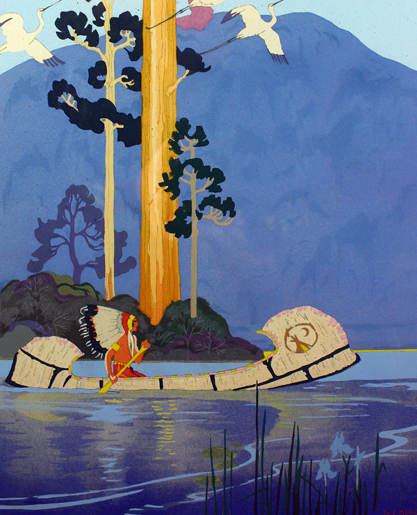 |
| Above: Framed view in original art deco enamel painted frame |
 |
| Above: The artist’s signature |
 |
| Above: Detail |
The second work from a pair of 1920s gouache paintings by the Minneapolis, Minnesota artist Lee Mero, titled “Land O’ the Sky Blue Water.” This retains its brightly colored pin striped art deco enamel painted wood frame. This was likely a commissioned work for the Buzza Motto Company who prospered during the Roaring 20s Jazz Age years providing prints, plaques, bridge tallies and menu books that captured the style and aesthetics of the burgeoning modernist art deco movement. This beautiful depiction of northern Minnesota’s 10,000 lakes glory captures the fascination with Native American culture with an Indian Chief in a birch-bark canoe and blue heron birds that are indigenous to the area.
 |
| Above: Frame detail |
 |
| Above: Verso title |
Lee Mero was a successful commercial artist and illustrator. Born May 30, 1885, in Ortonville, MN, Lee V. Mero was a younger brother of Dr. Frank H. Mero, a prominent Little Falls dentist around the turn of the century. The Little Falls Daily Transcript followed the accomplishments and exploits of Lee Mero, and through those newspaper articles the story of a talented artist unfolds.
Lee Mero studied art and illustration at the Minneapolis School of Art and later at the Chase School of Art in New York City – both schools which famous Little Falls artist George W. Harting also attended. During the summer of 1908, Lee worked as purser on the steamboat Hopkins on Lake Minnetonka, and made headlines when he saved the life of a seven year old girl who fell overboard and was rescued by Mero. His artistic talents also made news as the Transcript in December 1910 reported that large lithographic reproductions of his drawings were on sale locally and were “attracting considerable attention.” Quoting from the Minneapolis Tribune, the Transcript in March 1913 carried a lengthy article regarding an exhibition of the Attic Club, a show which included two controversial works by Lee Mero. Done in the Cubist style, his “A Gentleman Eating Noodle Soup” led the Tribune to muse, “It is expected that this painting will create a furor,” when exhibited along with his other painting, “The Loss of the 29,000 Hairpins”. Furor or not, the Tribune in August 1913 admired Mero as “the artist who painted the Minneapolis scenes reproduced in the charming booklet issued by the Civic and Commerce association for the use of visitors.”
In February 1917, Mero spent a month in New York City and made the headlines again when he was arrested for drawing the Brooklyn Bridge! The Transcript, again quoting the Tribune, had a field day explaining how this “prominent member of the Minneapolis art circle” and “respected and admired member of the Attic Club” had so innocently set out to draw the Brooklyn Bridge only to be arrested as a spy. The arresting officer applied the cuffs to innocent Lee, who was unaware that such an act was any violation during the height of World War One. Soon released by a police captain with a stern warning, Mero stayed in New York City long enough to attend a reunion of 21 alumni of the Minneapolis School of Art who resided in the Gotham area and gathered at the famous studio loft of George W. Harting. The following year, Lee won both first and third prizes at the 1918 Minnesota State Fair art exhibit.
Married to Kathryn Rice of Fargo in 1920, Lee briefly moved to Chicago, working for the Chas. D. Frey Advertising Co. where he designed ads for Coca-Cola. Returning to Minneapolis, he became head of the art department of the George Buzza Company (later Buzza-Cardoza Co.), working on poem cards and posters and contributing art for their famous Buzza Motto pictures.
Becoming a highly successful creator of Christmas cards led Mero to work as a freelance artist in 1937, and he was a longtime contributor to the Augsburg Publishing House’s famous annual Christmas publication. Lee continued to find success freelancing in design, decorative illustration, creating mottos and greeting cards, until his retirement around 1971. Lee Mero passed away in 1977 at the age of 92.
